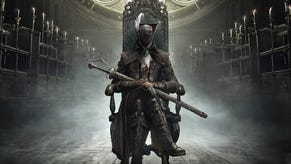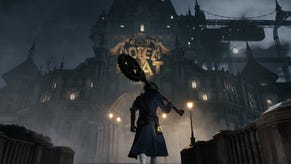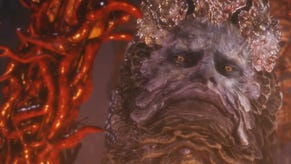What's going on in Bloodborne: The Old Hunters?
Man's inhumanity to man. The new lore explored and explained.
Hidetaka Miyazaki and From Software have an outstanding approach to narrative design, creating worlds where the systems and lore are intertwined from first principles. These are not games with simple stories, easy answers, or even good and bad - which is why fans find their heady brew of fact, myth, and suggestion so intoxicating.
With that said, Bloodborne's expansion The Old Hunters adds so much to our understanding of this game's world that we're going to (mostly) leave aside the game systems and look at how it adds to the original narrative. If you want a refresher, here's my old article on that. There's simply not space to cover everything, so topics like Valtr, the Cathedral basement and in-depth analysis of the Research Hall will have to wait for another day.
The first thing to say about the Old Hunters, which might sound crazy but I'm 100 per cent sure, is that we experience events in reverse order - the DLC begins next to Laurence and the Cathedral, takes us through Ludwig (who is first 'the accursed', and then 'the holy blade'), then on to the Research Hall and the Church's first experiments, and finally the fishing hamlet where the corpse of a Great One washed up. All of this happened the other way around.
The fishing hamlet
We know that the Great One Kos was dead when it washed up at the fishing hamlet, because the Kos Parasite's description calls the body a "carcass." This event led to Byrgenwerth's scholars, including presumably Laurence and Master Willem, descending on the town. The Great One, though dead, was pregnant.
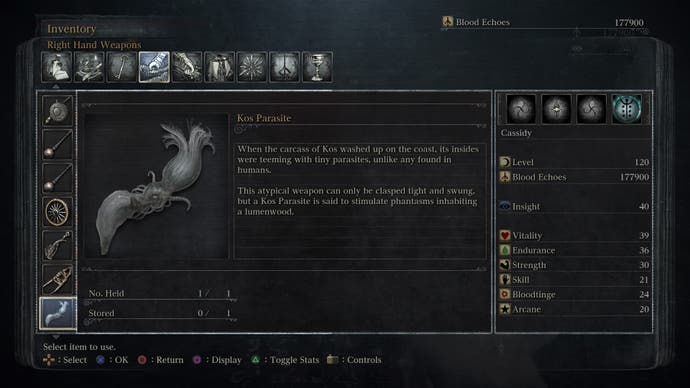
The fishing hamlet's inhabitants' proximity to a Great One was seen as sufficient grounds for research - specifically, what seems to have been trepanning them in a search for 'inner eyes.' The Accursed Brew description states it is the "Skull of a local from the violated fishing village. The inside of the skull was forcibly searched for eyes, as evidenced by innumerable scratches and indentations." Most do not seem to have survived the process, and those that did are crazed.

One final point - the piles of 'fish' around the fishing hamlet are not fish. They're slugs, presumably the parasites drawn to Kos, and bear close resemblance to other items linked to the Great Ones. We may also remember Micolash's line asking Kos to grant us eyes, "as you once did for the Vacuous Rom."
Laurence's role
At the opening of the fishing hamlet we meet a crazed figure who mutters about Byrgenwerth, calling them "blasphemous murderers... blood-crazed fiends." The figure goes on to talk of "the poor, wizened child" before repeating, as if by rote: "Lay the curse of blood upon them, and their children, and their children's children, forevermore."
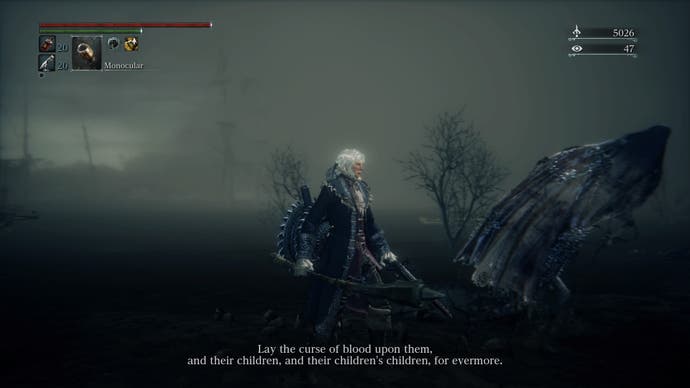
There are many sideways references to what happened at the fishing hamlet, and we know that the village and its inhabitants were "violated," but this explicitly suggests what the big secret of the Healing Church is - the original sin, if you like. The carcass of Kos was teeming with various life and, specifically, a Great One's child - known only as the Orphan of Kos. The Church, under Laurence's instructions, dissected Kos's carcass and in the process of doing so - perhaps inadvertently - slaughtered the child. They wanted a Great One's blood, and got it. It is likely the physical carrying-out of the deed was done by either Gehrman or his greatest apprentice, Maria, more on whom soon.
We know from Laurence's skull that it is "a symbol of Laurence's past, and what he failed to protect." What he failed to protect, given it's a human skull and we know he's the first cleric beast, is his humanity - Laurence did not "fear the Old Blood" enough. In fact, he went the complete other direction by committing deicide.
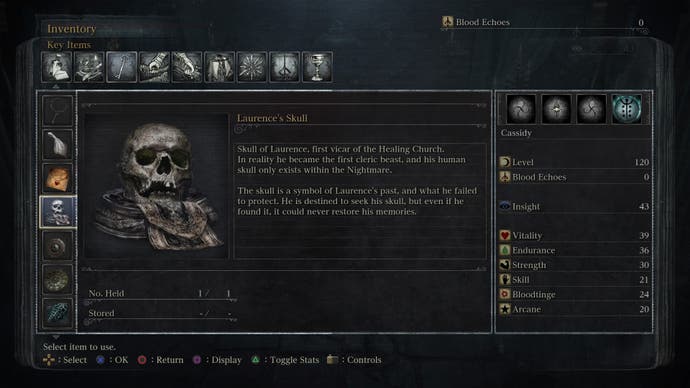
At bottom of The Old Hunters lies the story of Laurence, and by extension Master Willem. We discovered the latter in Bloodborne at what remained of Byrgenwerth, still living and - though not capable of speech - capable of pointing us in the direction of Rom. Willem's focus was Insight, "what we need are more eyes," and not blood. So he met the fate, if you like, of the abstract intellectual - Willem is spaced-out, immobile and a host to various polyps.
The counterpart to this fate is Laurence, who instead of becoming insensible becomes a terrible beast. It's pointed that Laurence is referred to as "the first Vicar," because the Latin root of that word is 'substitute' - and this was his role in Bloodborne, trying to find a shortcut to the Great Ones through using blood rather than Insight.
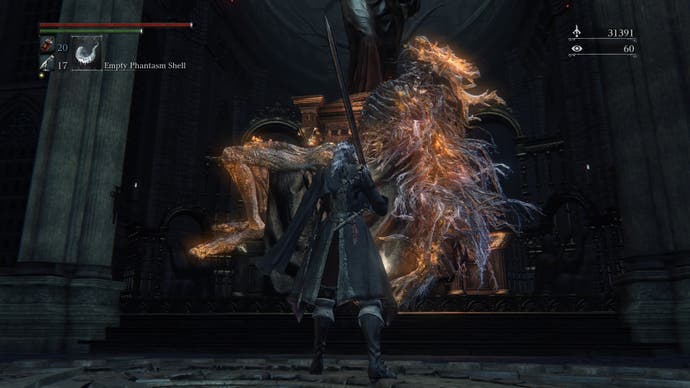
We can see Willem and Laurence as opposites, the former driven by the desire for knowledge but retaining the true scholar's respect for his subject - and trying to warn his greatest student away from easy or drastic solutions. In the corpse of Kos and the still-living child, Laurence saw the opportunity to make what had been an intellectual pursuit into something much more visceral - to become gods not by communing with them, but through physical adaption and absorption. Scholars of Byrgenwerth went to the fishing hamlet, we know this from the mutterings of the crazed man at the location's beginnings, but this may have been the moment when its members split between Willem and Laurence, and the Healing Church came to be.
Willem eventually loses his mind, or most of it anyway, but Laurence damns himself and everyone in Yharnam by unleashing the scourge of beasts - of which he is probably the first. You could also say that Laurence is responsible for locking the hunters into their own endless cycle of nightmares (through the killing of Kos's child, which curses all hunters), and the death of Gehrman's beloved Maria, and every other split and tragedy in the history of hunters.
Gehrman and Maria
Several parts of Bloodborne are bound-up in Maria. She is the last guard before the fishing hamlet, and committed an act there which disgusted her. She is linked to Cainhurst's Queen in her weapon's description, and her neck is red with blood like Queen Yharnam. She gets rid of her beloved weapon Rakuyo: "casting it into a dark well, when she could stomach it no longer."

She is also the model for the Doll. "Among the first hunters, all students of Gehrman, was the lady hunter Maria," states her armour, before concluding that she "had great admiration for Gehrman, unaware of his curious mania." The physical resemblance is obvious but the use of the word mania confirms it, which recurs in the description of the Doll's hat which "borderlines on mania."
Further to this we gain the Old Hunter bone from the same gravestone in the Old Workshop that, in the Dream workshop, is used to access the nightmare. In the battle Maria will use quickening but - unlike every other character that uses it - she has no animation for using the bone. The only conclusion is that it is hers. The Doll also has a habit of praying at this gravestone.
Nightmares in Bloodborne are hard things to define, but one thing we do know is that in the case of the Nightmare of Mensis there was a human host that allowed us to access it - Micolash. The actual nightmare in that case was Mergo, Queen Yharnam's lost child, but Micolash is faced and defeated before this point and the Nightmare's reality holds strong. We also know, from where we entered the nightmare, that Micolash is long-dead.
I suggest Maria is the host of the Old Hunter's nightmare, in the sense that we access it through her gravestone, and she is clearly long-dead, but in this world she lives on and links nearly every major character or faction to Kos - Gehrman, Laurence, Cainhurst, Queen Yharnam, and the hunters. Maria's weapon speaks of her distaste for blood, and yet she was one of those that put an innocent village to the sword.
The big question is between two possible interpretations. Some might say that Byrgenwerth dissected Kos and experimented on the villagers, and the curse placed on the Church and hunters comes from the Orphan of Kos. After all, the Great Ones are "sympathetic in spirit."
But the Orphan of Kos is not the source of the nightmare. The nightmare is a shadowy form that appears on the corpse of Kos after killing the Orphan. When you slay it with a single stroke, a short cutscene plays. I believe this features the voice of Gehrman, who is also heard sobbing at the fight's beginning when the Orphan of Kos is being born.
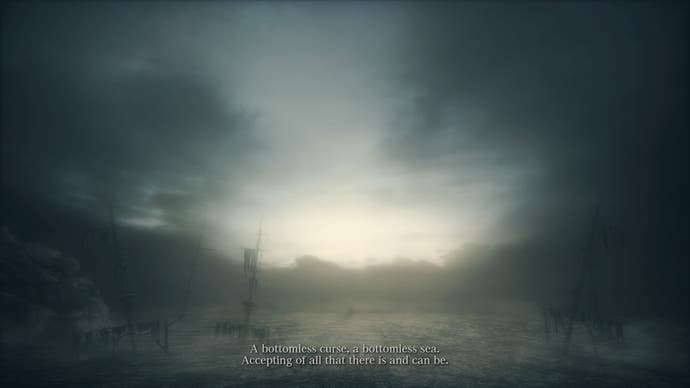
When you first see Maria she is lifeless - another echo of the Doll - but grabs your hand as it moves towards her, saying "corpses should be left well enough alone." If we look closely Maria's neck is bloodied and her blood pools at her feet. The visual is an echo of Queen Yharnam, and the implication is suicide.
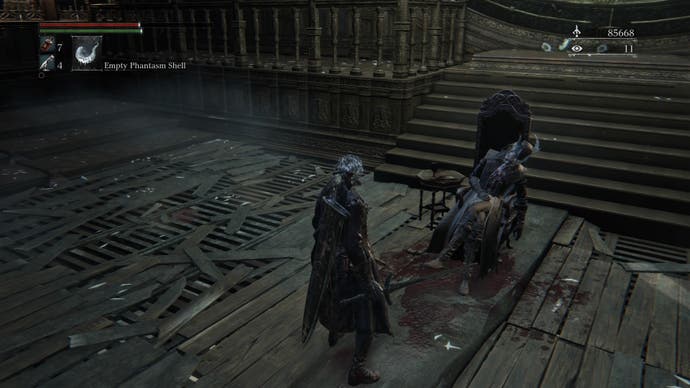
So we return to "blasphemous murderers." This is where I make the leap that the great sin, which saw the hunters cursed, was the dissection of Kos's corpse and through this the death of the child it was carrying. The Orphan of Kos may be alive in the Nightmare - but so are a lot of other things we know to be dead (Laurence, Maria, Ludwig) - and it most notably of all takes the form of a hunter, using the placenta as a trick weapon, as if it were an embodiment of purpose.
This curse is what has trapped Gehrman, and his children and children's children - the hunters. As the first hunter Gehrman bears the load of Laurence and Willem's actions, has lost his love whom he tries to replace with a contraption, and is doomed to watch the hunters go mad in a perpetual cycle. The weeping at the start of the Orphan of Kos fight echoes the weeping we overhear if we catch Gehrman sleeping in the dream. He begs Willem and Laurence for help. "Unshackle me, please, anybody... I've had enough of this dream."
After killing Maria one can return to see the Doll, and she will say that she feels she has been "liberated from heavy shackles." Note the repetition of the shackle concept. Finally, after slaying the Nightmare, the Doll will say this: "Oh good hunter, I can hear Gehrman sleeping. On any other night, he'd be restless. But on this night, he sounds so very calm... Perhaps something has eased his suffering."
Note the subterranean suggestion of death in the final line: the concept of 'easing suffering.' I've always found it interesting that Gehrman's weapon is a scythe, which we would associate with the grim reaper. Maria was the host of the nightmare, but was it her or Gehrman that started it?
And the rest...
The above is an interpretation of the overall arc of The Old Hunters but there's much more to discover in there - the old hunters themselves, who were "ten-a-penny," the constable Valtr and his origins, the Research Hall which is the beginnings of the Choir.
We enter the Hunter's Nightmare through the 'Eye of a blood-drunk hunter.' "A hunter who goes drunk with blood is said to be taken by the Nightmare, destined to wander forever, engaged in an endless hunt. It is a fate that no Hunter can escape."
Among other things, this suggests that the scourge is associated with screwed-up eyes - which explains why so many characters in the game have face coverings of some description. And then we can consider the link to Insight, and its association with eyes and how some characters talk of 'not being able to see.'
I've written more than 2000 words and barely scratched the surface of The Old Hunters - such is the beauty of Bloodborne. The implications of this expansion for the wider narrative are huge, not least in our understanding of the Healing Church and their experiments, but such will have to wait.
In the end I return to Willem and Laurence. These characters can be seen as the twin poles of humanity, or being human: does the body rule the mind or vice-versa? Willem represents our intellectual capacity, the drive towards deeper understanding, while Laurence is ultimately an embodiment of flesh and blood in its most visceral form. The capacity for beasthood is inherent in man, rather than being something the Great Ones introduced (look at any beast item description.) Laurence's human skull may not be real but, as a visual symbol of the man that he was, it is notable for the total absence of Insight.
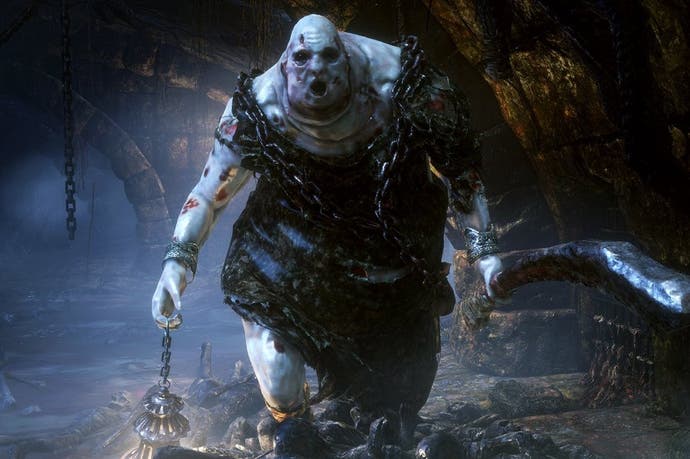


.png?width=291&height=164&fit=crop&quality=80&format=jpg&auto=webp)

